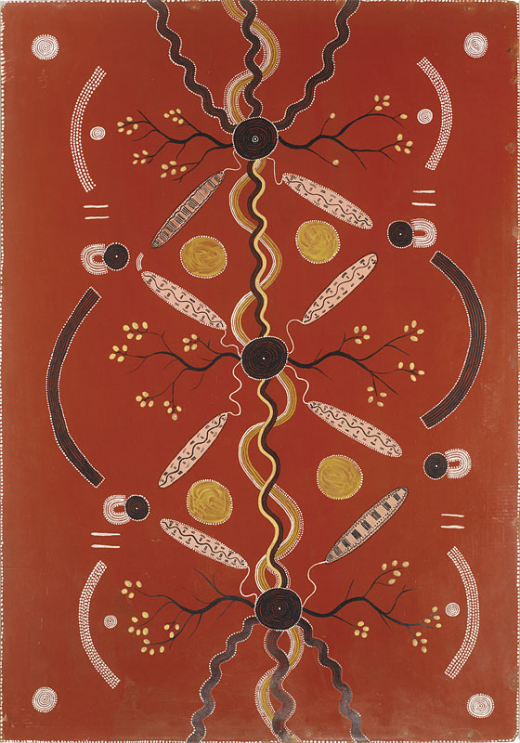Kaapa Mbitjana Tjampitjinpa, circa 1926-1989, WILD ORANGE DREAMING
Kaapa Mbitjana Tjampitjinpa, circa 1926-1989, WILD ORANGE DREAMINGEstimate $40,000 – $60,000
- Lot Sold $38,000 (Hammer Price)
- $45,600 (Hammer Price with Buyer's Premium)
natural earth pigments and synthetic binder on composition board
103 BY 71CM
Provenance:
Painted at Papunya in December 1971
Private collection
Sotheby's, Aboriginal Art, Melbourne, 9 July 2001, lot 191
Private collection, USA
Literature:
Geoffrey Bardon, Papunya Tula: Art of the Western Desert, Melbourne: McPhee Gribble, 1991, p.109 (illus.)
Geoffrey Bardon and James Bardon, A place made after the story; The Beginnings of the Western Desert Painting Movement, Melbourne: Miegunyah Press, 2004, p.186, ptg. 96 (illus.)
In his book, Geoffrey Bardon writes of the artist's paintings at the time: 'Kaapa's spatial control, elegant symmetry, classic balance and exquisite filigree variations on decorative motifs gave his work its distinctive monumental presence and heraldic clarity and splendor. However, the social tensions within the painting group spilt over ferociously into his work. He was the most vigorously symmetrical of the painters, yet his paintings are a compendium of sacred signs with secular subject matter. Kaapa consistently allowed the secular and the sacred to clash in his symbology. His intrusive icons were forever commenting on (and thereby, it seemed to me, questioning) the tribal traditions. Along with sacredness and secrecy, Kaapa threw his traditions to the wind, expressing instead a grim horror of the environment he was obliged to endure in the here-and-now' (Bardon, 1991, p.108).
In the accompanying annotated diagram published in his book, Bardon identifies the four concentric circles in the corners of this painting as sand mosaics; the four large yellow ochre circles towards the centre - as wild orange; the six arch shapes along the perimeter - as wind breaks; the meandering foliage emanating from the central roundels - as the flowers and seeds of orange tree; the elongated ovoid objects - as tjuringa (sacred objects); and the meandering lines that traverse the board - as body paint. The four small ‘U' shapes alongside the black concentric circles represent corroboree men beside fires. Bardon further comments: ‘This skillfully painted version of the Wild Orange Dreaming shows traditional symmetry as well as European influences' (ibid, p.109).

